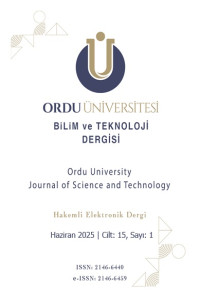Abstract
Laboratuvarda tuz tayini için en yaygın kullanılan yöntemlerden biri olan Mohr yönteminin geçerliliğini doğrulamak için validasyon çalışmaları yapılmıştır. Kesinlik (tekrarlanabilirlik ve tekrar üretilebilirlik) ve doğruluk yöntem validasyon parametreleridir. Tekrar üretilebilirlik ve tekrar üretilebilirlik koşulları altında elde edilen Bağıl Standart Sapma (RSD) değerleri konsantrasyona bağlı kesinlik değerleri ile karşılaştırılmış ve sonuçlar uygun bulunmuştur. Doğruluk çalışması standart referans madde kullanılarak yapılmıştır. Sonuçların gerçek değere yakın olup olmadığını belirlemek için t-testi kullanılmış ve sonuçlar uygun bulunmuştur. Sonuç olarak Mohr yönteminin validasyon çalışmaları tamamlanmış ve laboratuvarımız için geçerlidir. Peynir tuzunun ölçüm belirsizliği üzerine bir çalışma da yapılmıştır. Bu nedenle Urfa peyniri ve kaşar peyniri tercih edilmiştir. Uygulanan analiz yöntemi ile ağırlık, hacim, kesinlik ve doğruluk olarak bilinen belirsizlik bileşenleri belirlenmiştir. Daha sonra bu belirsizliklerden kaynaklanan belirsizlikler birleştirilerek genişletilmiş belirsizlik hesaplanmıştır. Genişletilmiş belirsizlik U(tuz)=0,028'dir.
Keywords
References
- Akdağ, İ. (2004). Metot validasyonu, ölçüm belirsizliği ve önemi. Tübitak-UME.
- Alper, N. (2004). HPLC ile gıdalarda benzoik ait ve sorbik asit analizi metod verifikasyonu ve ölçüm belirsizliği. TUBİTAK-UME.
- Anderson, S. W., Daily, J. D., & Johnson, M. F., (1999). Why firms seek iso 9000 certification: Regulatory compliance or competitive advantage. Production and Operations Management, 8(1), 28-43. https://doi.org/10.1111/j.1937-5956.1999.tb000
- Association of Official Analytical Chemists (1998). AOAC® peer-verified methods program: Manual on policies and procedures. AOAC International.
- Araujo, P. (2009). Key aspects of analytical method validation and linearity evaluation. Journal of chromatography B, 877(23), 2224-2234. https://doi.org/10.1016/j.jchromb.2008.09.030 Bulska, E., & Lipiński, J. (2018). Metrology in chemistry. Cham: Springer International Publishing.
- Çelebiler, A., Serin, H., Güleç, D., & Karaca., B. (2011). Klinik biyokimya laboratuvarında ölçüm belirsizliği. Türk Biyokimya Dergisi, 36(4), 362–366.
- Douglas, A., Coleman, S., & Oddy, R. (2003). The case for ISO 9000. The TQM Magazine, 15(5), 316-324. https://doi.org/10.1108/09544780310487712
- Ertaş, Ö., & Kayali, A. A. 2005. Analitik yöntem geçerliliğine genel bir bakış. Ankara Ecz. Fak. Derg, 1, 41-57.
- İnal, B. B., & Topkaya, Ç. (2010). Klinik biyokimya laboratuvarlarında akreditasyona geçiş. İstanbul Tıp Dergisi, 2, 74-76. https://jag.journalagent.com/istanbultd/pdfs/ITD_11_2_74_76.pdf
- Krismastuti, F. S. H., & Habibie, M. H. (2022). Complying with the resource requirements of ISO/IEC 17025: 2017 in Indonesian calibration and testing laboratories: current challenges and future directions. Accreditation and Quality Assurance, 27(6), 359-367. https://doi.org/10.1007/s00769-022-01523-w
- Menditto, A., Patriarca, M., & Magnusson, B. (2007). Understanding the meaning of accuracy, trueness and precision. Accreditation and Quality Assurance, 12, 45-47. https://doi.org/10.1007/s00769-006-0191-z
- Uras, F. (2009). Quality regulations and accreditation standards for clinical chemistry in Turkey. Clinical Biochemistry, 42(4-5), 263-265. https://doi.org/10.1016/j.clinbiochem.2008.09.008
- Sezey, M., & Adun, P. (2019). Validation of mohr titration method to determine salt in olive and olive brine. Journal of the Turkish Chemical Society Section A: Chemistry, 6(3), 329-334. https://doi.org/10.18596/jotcsa.496563
Method Validation and Calculation of Measurement Uncertainty for Salt Determination in Cheese by Mohr Method
Abstract
Validation studies were conducted to verify the validity of the Mohr method, which is one of the most common methods for salt determination in the laboratory. Precision (repeatability and reproducibility) and accuracy are method validation parameters. Relative standard deviation (RSD) values obtained under reproducibility and repeatability conditions were compared with concentration-dependent precision values, and the results were appropriate. The accuracy study was carried out using a standard reference substance. The t-test was used to determine whether the results were close to the true value, and the results were found to be appropriate. As a result, the validation studies of the Mohr method were completed and are valid for our laboratory. A study on the measurement uncertainty of cheese salt was also conducted. Therefore, Urfa cheese and kashar cheese were preferred. The applied analysis method determined the uncertainty components known as weight, volume, precision, and accuracy. Then, the expanded uncertainty was calculated by combining the uncertainties resulting from these uncertainties. The expanded uncertainty is U(salt) =0.028.
Keywords
Ethical Statement
There is no any ethical issue in publishing this article.
References
- Akdağ, İ. (2004). Metot validasyonu, ölçüm belirsizliği ve önemi. Tübitak-UME.
- Alper, N. (2004). HPLC ile gıdalarda benzoik ait ve sorbik asit analizi metod verifikasyonu ve ölçüm belirsizliği. TUBİTAK-UME.
- Anderson, S. W., Daily, J. D., & Johnson, M. F., (1999). Why firms seek iso 9000 certification: Regulatory compliance or competitive advantage. Production and Operations Management, 8(1), 28-43. https://doi.org/10.1111/j.1937-5956.1999.tb000
- Association of Official Analytical Chemists (1998). AOAC® peer-verified methods program: Manual on policies and procedures. AOAC International.
- Araujo, P. (2009). Key aspects of analytical method validation and linearity evaluation. Journal of chromatography B, 877(23), 2224-2234. https://doi.org/10.1016/j.jchromb.2008.09.030 Bulska, E., & Lipiński, J. (2018). Metrology in chemistry. Cham: Springer International Publishing.
- Çelebiler, A., Serin, H., Güleç, D., & Karaca., B. (2011). Klinik biyokimya laboratuvarında ölçüm belirsizliği. Türk Biyokimya Dergisi, 36(4), 362–366.
- Douglas, A., Coleman, S., & Oddy, R. (2003). The case for ISO 9000. The TQM Magazine, 15(5), 316-324. https://doi.org/10.1108/09544780310487712
- Ertaş, Ö., & Kayali, A. A. 2005. Analitik yöntem geçerliliğine genel bir bakış. Ankara Ecz. Fak. Derg, 1, 41-57.
- İnal, B. B., & Topkaya, Ç. (2010). Klinik biyokimya laboratuvarlarında akreditasyona geçiş. İstanbul Tıp Dergisi, 2, 74-76. https://jag.journalagent.com/istanbultd/pdfs/ITD_11_2_74_76.pdf
- Krismastuti, F. S. H., & Habibie, M. H. (2022). Complying with the resource requirements of ISO/IEC 17025: 2017 in Indonesian calibration and testing laboratories: current challenges and future directions. Accreditation and Quality Assurance, 27(6), 359-367. https://doi.org/10.1007/s00769-022-01523-w
- Menditto, A., Patriarca, M., & Magnusson, B. (2007). Understanding the meaning of accuracy, trueness and precision. Accreditation and Quality Assurance, 12, 45-47. https://doi.org/10.1007/s00769-006-0191-z
- Uras, F. (2009). Quality regulations and accreditation standards for clinical chemistry in Turkey. Clinical Biochemistry, 42(4-5), 263-265. https://doi.org/10.1016/j.clinbiochem.2008.09.008
- Sezey, M., & Adun, P. (2019). Validation of mohr titration method to determine salt in olive and olive brine. Journal of the Turkish Chemical Society Section A: Chemistry, 6(3), 329-334. https://doi.org/10.18596/jotcsa.496563
Details
| Primary Language | English |
|---|---|
| Subjects | Analytical Chemistry (Other) |
| Journal Section | Research Articles |
| Authors | |
| Publication Date | June 30, 2025 |
| Submission Date | November 5, 2024 |
| Acceptance Date | June 25, 2025 |
| Published in Issue | Year 2025 Volume: 15 Issue: 1 |


